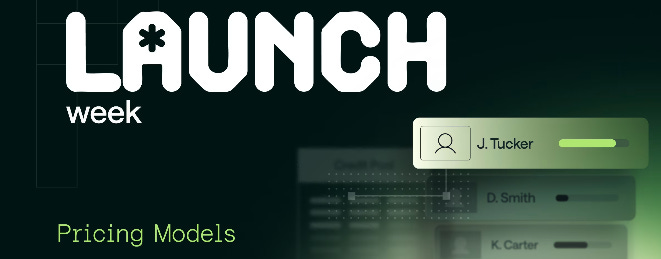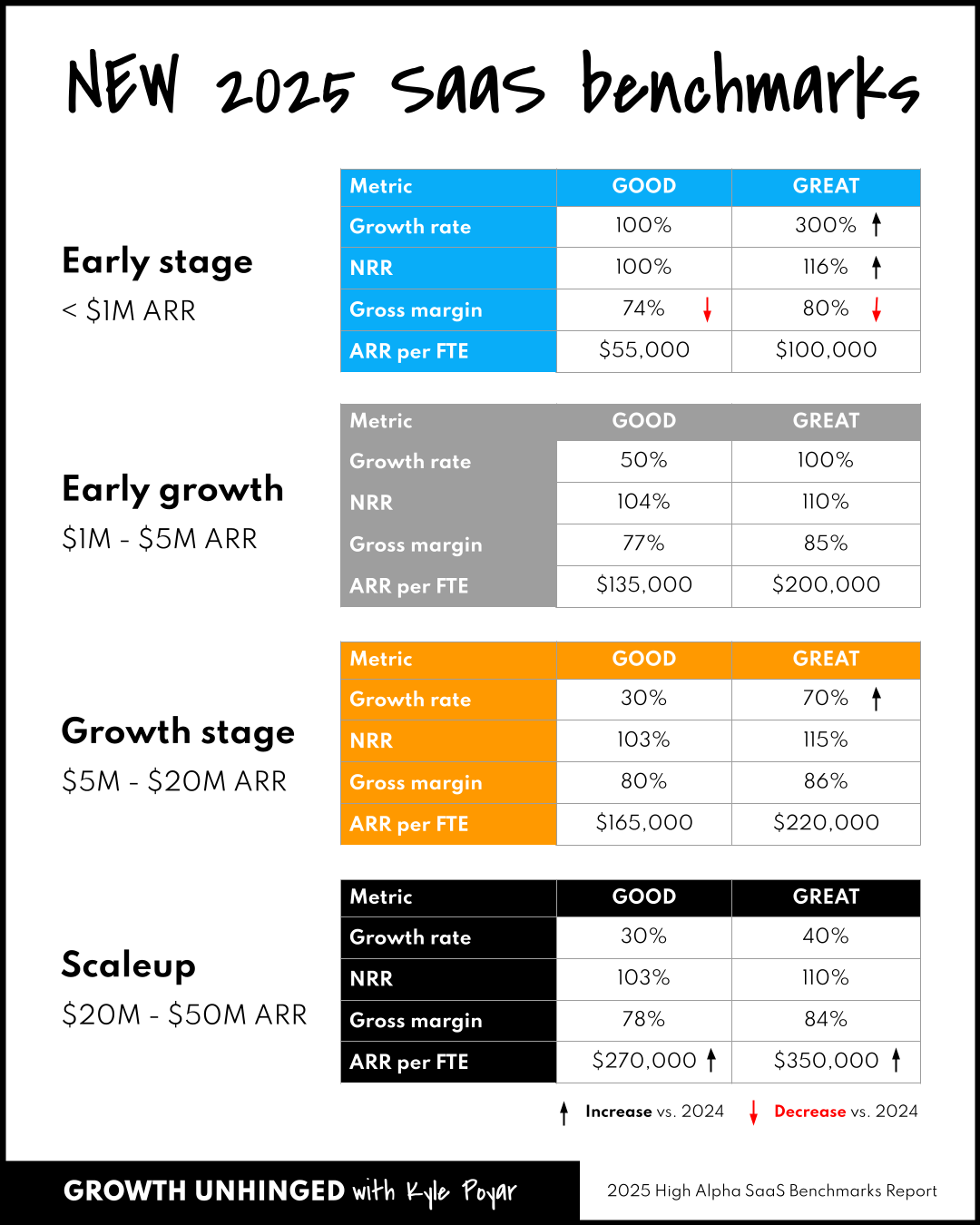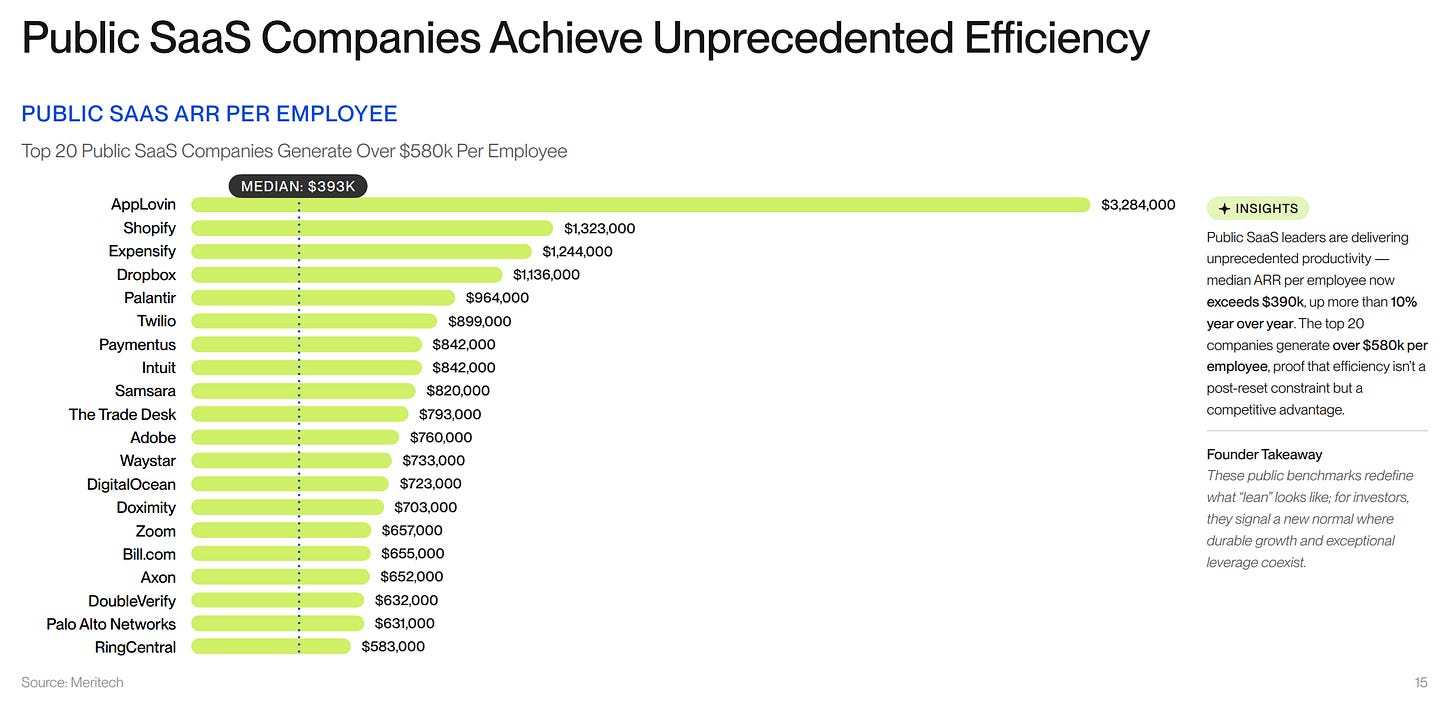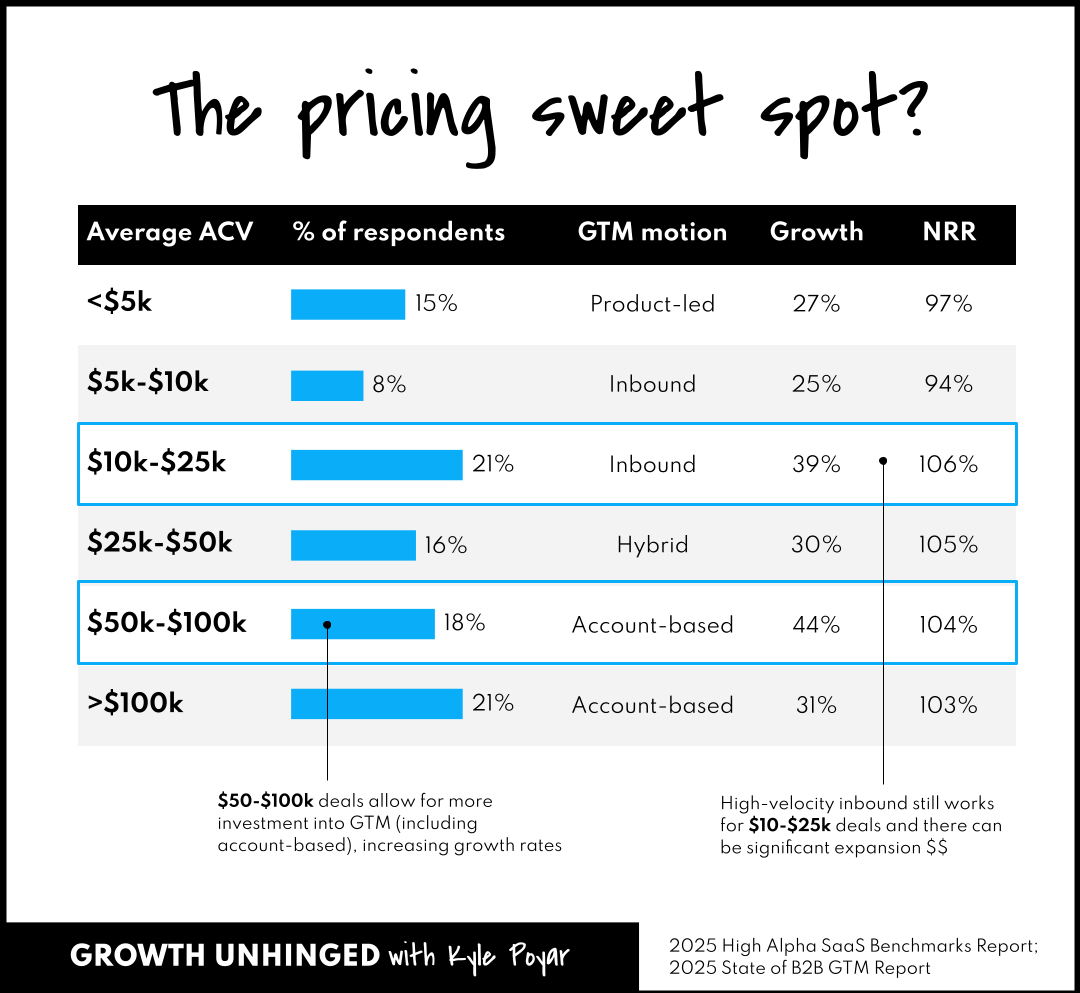What's really going on in software
New data from 800 companies in the 2025 SaaS Benchmarks report

SaaS pricing used to be, well, kind of boring. AI pricing certainly isn’t.
AI products come with real (and seemingly ever-changing) costs. Many products are exploding out of the gate, raising the stakes for getting pricing right fast. Monetization infrastructure needs to adapt as quickly as your product does.
My friends at Metronome are here to help and they’ve just launched three new 🔥 capabilities: seat-based credits, packages for good-better-best PLG tiers, and account hierarchy for complex enterprise contracts. Learn more about Metronome’s new unified monetization infrastructure here.
The 2025 SaaS Benchmarks report
Over the past nine (!) years I’ve now surveyed 5,000 private B2B software companies to figure out what’s going on in the industry. The SaaS Benchmarks report has become an annual pulse check into what’s happening with growth rates, headcount, pricing, and efficiency.
I’m so excited to continue producing the report alongside my friends at High Alpha, the B2B SaaS venture firm. Over 800 companies participated this time around, which sets a new record for us.
Keep reading for the most interesting takeaways from the 2025 SaaS Benchmarks. Then download the full 60-page report here.
How do you compare? Benchmarks across the big SaaS metrics.
The Efficient Growth matrix. Forget LTV:CAC, look at this instead.
The AI growth story. AI-native startups aren’t like B2B SaaS.
How AI is impacting tech jobs. Engineering gets hit first.
A pricing sweet spot? New data on deal sizes and growth.
Who participated in the research
This report draws our largest dataset to date with more than 800 participants. A typical respondent was a B2B SaaS company based in the US and generating $5-20M ARR. Research was conducted in August and September 2025.
The participants-at-a-glance:
ARR: Less than $1M (23%), $1-$5M (27%), $5-$20M (31%), $20-$50M (10%), greater than $50M (9%).
HQ location: US (69%), Europe (17%), Canada (4%), elsewhere (10%).
ICP: Enterprise (37%), midmarket (35%), SMB (19%), micro-business (7%), consumer (2%).
Takeaway 1: How do you compare? Benchmarks across the big SaaS metrics.
First things first: a summary of what’s good (50th percentile) and great (75th percentile) across growth rates, net revenue retention (NRR), gross margins, and ARR per full-time employee (FTE).
Last year’s theme was market stabilization. After big swings up and then down, 2024 looked a lot like 2023.
There’s been so much change in 2025. Yet most metrics barely budged. This year’s theme is, surprisingly, continued stabilization.
There were a few differences to point out:
The best early-stage startups are re-accelerating. Top quartile growth rates for <$1M ARR startups are back up to 300% year-on-year. This is materially higher from 2023 (150%) and 2024 (250%).
Gross margins are getting compressed. They’re down nearly 10 pts year-on-year for early-stage companies, likely driven by AI costs.
Later-stage companies are getting profitable. While scaleups are growing at the same rate as last year, they’re doing so with far fewer employees. Best-in-class ARR per FTE jumped by 42% for companies with $20-50M ARR (to $350k) and by 50% for those with greater than $50M ARR (to $400k). This mirrors trends in the public markets (more on that later).
Takeaway 2: The Efficient Growth matrix. Forget LTV:CAC, look at this instead.
I’ve analyzed data on nearly 5,000 software companies over nine years. As much as I’ve searched for novel insights, one thing never seems to change. The two strongest predictors of long term and profitable growth are CAC payback period and net revenue retention (NRR).
There metrics are usually looked at separately. If you bring them together, the picture becomes incredibly clear:
High NRR and low CAC payback period (13% of respondents): 71% average growth rate and 47% Rule of 40. This is the cash cow zone.
High NRR and high CAC payback period (15% of respondents): 40% average growth rate and 21% Rule of 40. This is the enterprise zone.
Low NRR and low CAC payback period (15% of respondents): 30% average growth rate and 33% Rule of 40. This is the high velocity zone.
Low NRR and high CAC payback period (12% of respondents): 10% average growth rate and 5% Ro40. This is the B2B SaaS danger zone.
If you aren’t in the top box today, fear not. You can reinvent yourself on the path from $1M to $20M ARR. The companies that made it to $20M ARR increased their NRR by 12% during that journey.
Takeaway 3: The AI growth story. AI-native startups aren’t like B2B SaaS.
70% of companies said they’ve launched AI features in their product and another 22% have AI features on their product roadmap. It’s getting nearly impossible to distinguish between those who say they have an AI product and those where AI is core to the product itself. (Many buyers are getting skeptical.)
This year we asked about AI head-on. Roughly two-in-three (64%) said AI is merely a supporting feature. The remainder (36%) said it’s core to their product.
Look at how stark the differences are between companies founded before and after ChatGPT, which launched in 2022. Relatively few of those founded before 2021 have managed to pivot to become AI-centric. Meanwhile, AI is core to three-in-four startups founded in 2022 or later.
I was curious to see how these AI-native startups compare to their SaaS peers. What the data shows: they’re growing three times faster, have 5 points lower gross margins, and are seeing better Rule of 40 performance (driven by higher growth rates).
The AI growth gap holds up across ALL revenue bands:
Less than $1M ARR: 100% median growth (AI-native) vs. 75% growth (B2B SaaS).
$1M-$5M ARR: 110% median growth (AI-native) vs. 40% growth (B2B SaaS).
$5M-$20M ARR: 90% median growth (AI-native) vs. 30% growth (B2B SaaS).
$20M-$50M ARR: 60% median growth (AI-native) vs. 35% growth (B2B SaaS).
Greater than $50M ARR: 40% median growth (AI-native) vs. 15% growth (B2B SaaS).
Related: How Fyxer AI grew from $1M to $17M ARR in 8 months; How Lovable became Europe’s fastest growing startup
Takeaway 4: How AI is impacting tech jobs. Engineering gets hit first.
Large public SaaS companies have dramatically increased their productivity as measured by ARR per employee. The top 20 now generate over $580k per employee.
Shopify, which says “reflexive AI usage is now a baseline expectation”, has seen the figure explode to $1.3M ARR per employee. Jason Lemkin from SaaStr pointed out that the company has 30% fewer employees compared to 2022 yet is generating double the revenue. (My quick math indicates ARR per employee tripled during that period.)
Later-stage companies in the SaaS benchmarks report have similarly increased ARR per employee, and they’re saying it’s because of AI adoption. 76% of those with greater than $50M ARR said they’ve reduced headcount due to AI.
The most impacted roles: engineering (42% reduced headcount due to AI) followed by customer success and support (27% reduced headcount due to AI), and marketing (26% reduced headcount due to AI). The roles least likely to be impacted by AI are in IT, people, finance, and sales. (I suspect people teams have been impacted by the lower hiring volume if not by AI specifically.)
The best way to get a tech job these days is to demonstrate AI fluency in the interview process. The number of B2B software GTM jobs requiring AI skills has grown by 14x in the past two years.
Takeaway 5: A pricing sweet spot? New data on deal sizes and growth.
If you could choose the best type of customer, what would they look like? Ideally, they would spend real money (large deal sizes), buy quickly (fast sales cycles), be eager to adopt new technology (inbound hand-raiser), and be prepared to spend more year after year (high NRR). We can dream, right?
Looking at the data, the best places to target seem to be $10k-$25k deals or $50k-$100k deals. Software companies with these deal sizes are seeing the fastest growth rates and the best retention.
I compared this to my recent State of B2B GTM report, which found that $10k-$25k is the tipping point where an inbound GTM motion remains effective. The combination of LinkedIn, SEO, and warm outbound to website visitors can work well here. The 21% of B2B SaaS companies with this average ACV are growing quickly (39%) and with above-average NRR (106%).
Those with smaller deals ($5k-$10k) rely on inbound, but can’t afford to spend as much to generate opportunities. Meanwhile, it’s harder for AEs to make money and customers tend to churn at higher rates. Those with slightly larger deals ($25k-$50k) find that inbound starts being less effective; however, it’s still hard to stand up and justify a fully account-based strategy.
The second tipping point comes with deals between $50k-$100k. Here’s where an account-based strategy becomes the most popular GTM motion. Software companies combine intent-based outbound, intimate events, and large conferences to engage their best-fit accounts. At the same time, deal sizes might still go under-the-radar with less scrutiny, negotiation, and approvals compared to six-figure purchases.
You might not be able to choose your customer. But if you can choose your deal size, perhaps pick either $10k-$25k or $50k-$100k.











+AI costs force you to rethink content ROI at those $10k-$25k deal sizes where inbound marketing still works. Your blog posts and other content now have to work much harder to turn visitors into paying customers.